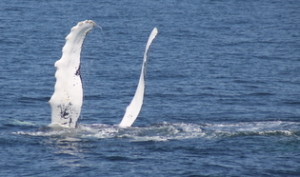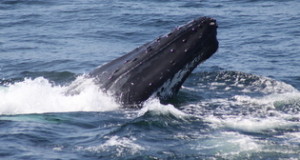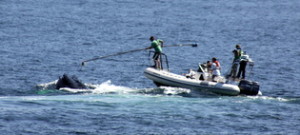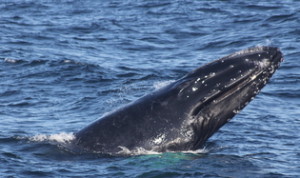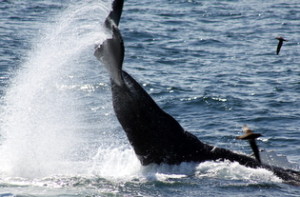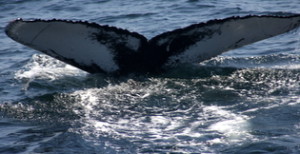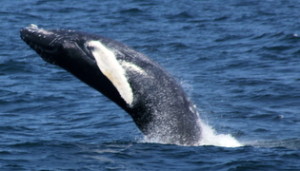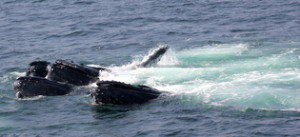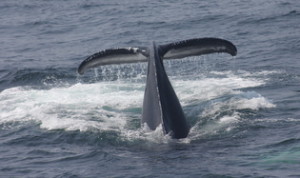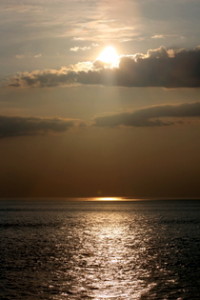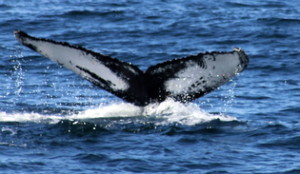July 9 to July 15
If you’re traveling with a group of kids, Saturday mornings are the best time to be aboard the Dolphin Fleet, as these cruises are specifically directed toward the younger set. On July 9th, the young and the young at heart took part in a lively, interactive discussion of whales that included the blubber glove experiment, a description of how baleen works, and a question/answer session of what makes a whale a mammal.
In the afternoon, the Dolphin IX brought us to the southeast corner of Stellwagen Bank for a true humpback whale feeding frenzy! We had over 20 humpbacks, including Salt, Stub, Dome, Infinity, Ganesh, and Ganesh’s calf.
Most of the adults were actively feeding, while the calves were nearby playing around, flipper slapping and tail breaching.
Meanwhile, we also got a chance to see scientists from the Stellwagen Bank National Marine Sanctuary, IFAW, Duke University, the Whale Center of New England, and National Geographic at work on their humpback whale tagging project. These scientists affix short-term, suction cup tags, equipped with a critter cam to the whales to monitor their use of the water column. They are also mapping prey in the area.
July 10th started out with low-key whales spread out across the southeast corner of Stellwagen Bank. We sidled up to Ganesh and her calf, who were logging. Logging is resting behavior common to buoyant whales, like humpbacks, who can float effortlessly at the surface. Scientists believe that whales can sleep with half of their brains at a time, using one hemisphere to regulate breathing while the other hemisphere rests. Just as we were about to leave, Ganesh woke up, apparently alerted to the presence of a nearby school of fish, and began to feed! She began to kick the water’s surface, immobilizing the fish, and then lunging through the school with a huge, open mouth!
In the afternoon, we returned to the southeast corner to find the whales still spread out. We followed a pair of humpbacks and were surprised when it executed one huge tail breach and then disappeared from sight! As we continued to head to the north, we located a new mother and calf pair. Although we were not able to determine the identity of the mother, we got great looks at both individuals. We ended our trip further to the north, where we found a very active humpback. This whale, who was breaching and flippering up a storm, was later identified as Moonlight, the 2006 calf of Springboard.
Active humpbacks continued to be the norm for the afternoon. As we encountered one lobtailing humpback, one group of girls on the bow of the Dolphin X were soaked as the whale slapped its huge tail down on the water unexpectedly right off our port side! When a humpback whale lobtails, one can often visually determine the sex of the whale. In the photos below, notice the two lobes beneath the whales flukes in the photo on the left. These lobes indicate that the whale is female. The absence of those lobes in the right hand photo show that the whale is a male.
Feeding picked up again in the evening. The Dolphin X made it to a big group of humpbacks, including Ganesh and her calf. Her calf rolled and played while Ganesh fed. The group was moving slowly to the south, but continued to kick and bubble feed along the way!
On the morning of July 11th, the Dolphin X encountered Springboard and Pumba traveling together. Pumba, named for the warthog-like marking on the underside of its tail, tail breached a few times, giving us a quick warning of its intentions by coming to a halt and spreading its flippers before launching its massive tail out of the water.
We went on to find the unidentified mom and calf seen the night before. While the mother humpback barely made an appearance, the calf was breaching up a storm. The wind was picking up and this little whale was clearly riled!
The mid-day boat opted for a change of scenery and headed to the southeast, rather than to the north where all the other boats were headed. Their adventurous spirit was rewarded as they found a large group of feeding whales, including Pogo, Fracture, Draco, Stub, Ampersand, Level, Infinity and Exclaim.
Blackhole and her calf were also sighted. Blackhole was first seen in 1998, this is her fifth calf.
July 12th began with hazy weather and lazy whales. Giraffe, Tectonic, Touche, and Tear were among the humpbacks spotted swimming about slowly on this hot morning.
Tear
By mid-day, the feeding action had recommenced, with at least 35 humpbacks within a 1/2 mile radius lunging to the surface with open mouths filled with fish!
With their long flippers providing great precision of movement, humpbacks can use a variety of techniques to trap and corral their prey. Throughout their northern feeding grounds, humpbacks can be seen blowing bubble nets to surround schools of fish, who cannot escape the walls of foam generated by either single or groups of whales.
Humpbacks may also use their powerful tails to kick feed, stunning and scaring their prey before they feed. Kick-feeding is thought to be a relatively new technique used specifically for sand lance.
Throughout the day, more and more humpbacks were drawn to the huge schools of fish east of the bank. Epee, Exclaim, Fracture, and Alphorn were among them. Not to be forgotten were the birds. A naturalist aboard the 2pm trip counted 4 different species of Shearwater. The Great, Sooty, Manx, and Cory’s shearwater were all present and accounted for!
The feeding frenzy slowed down by the evening, but our excitement was piqued again when we found that Venom, a humpback observed last year with damage to her tail, was seen with her first calf! We are happy to see that she is healthy, and that at the age of 15, is finally a calving female!
As both the whales and the seas calmed for the evening, we headed back to shore enjoying a beautiful sunset.
The feeding started up again on the morning of July 13th. Some of the usual suspects were around, with new flukes as well, including Ampersand, Coral, Ganesh, Fern, and Glostick!
As the afternoon went on, the wind, as well as the whales, came to a standstill. The breeze dropped off so our afternoon trips sailed across smooth, flat calm seas. The whales had stopped feeding and were dispersed, and many were logging. Luckily, one small unidentified humpback hadn’t lost steam and spent a good half hour chin breaching, flipper slapping, and breaching!
In the evening, we watched a cold front move in which whipped the wind from the southeast to the northwest. Then, there was a huge downpour! Luckily, the whales were still around and seemed to be congregating along an upwelling visible at the surface; however, all in all, the whales were moving pretty slow. Luckily, Ganesh’s calf saved the day by rolling, flipper slapping, and undulating at the surface.
High winds caused us to cancel trips on July 14th, and so on July 15th, it was the job of the 9am trip aboard the Dolphin VIII to find the whales! Passengers aboard the Dolphin IX were excited to see Sloop and Giraffe, both female humpbacks.
By mid-afternoon, feeding started again and we were excited to see Salt in the mix. Salt was first seen in 1975 and has been returning to Stellwagen Bank every summer to feed since then.
By the afternoon, the sand lance seem to have been spending more time deeper in the water column, and the whales followed suit, although we were able to get good looks every ten minutes or so when they surfaced for a breath.
One of our naturalists also noted some interesting behavior on the part of a trio of Minke whales in the area. Minke whales in the Gulf of Maine are generally solitary, but these three Minkes were seen coordinating their movements on multiple surfacings! Minkes are rather elusive and it is hard to get good enough looks at them to determine their behavior.
Mark your calendars! Whale Week, sponsored by the Provincetown Center for Coastal Studies is happening from July 25 – July 30. Visit their website for a list of events.







